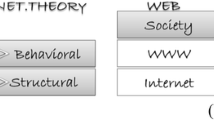Abstract
The spatial activity patterns of firms in a multi-regional system are closely connected with the structure and evolution of regional labour markets. Based on an extensive data set (cross-section) on commuting flows in Germany, this paper aims to identify the relationship between entrepreneurial activity and spatial labour markets, by employing in particular the concept of ‘entrepreneurial city’. A network connectivity model is adopted to assess connectivity patterns, using the power-law and exponential law as a statistical test framework, in order to detect the presence of economic activity hubs that may resemble the concept of entrepreneurial cities. Various results are presented and interpreted in the final part of the paper.
Similar content being viewed by others
References
Alderson LL, Reisko T, Doyle JC, Willinger W (2004) Towards a theory of scale-free graphs: definition, properties, and implications. California Institute of Technology, Engineering and Applied Sciences Division, Technical Report CIT-CDS-04-006
Audretsch DB (1995) Innovation and industry evolution. Cambridge MIT Press, Cambridge
Audretsch DB (2004) Sustaining innovation and growth: public policy support for entrepreneurship. Ind Innov 11:167–191
Audretsch DB, Thurik R (2001) Linking entrepreneurship to growth. OECD STI Working Paper, No 2001/2
Audretsch DB, Fritsch M (2002) Growth regimes over time and space. Reg Stud 36:113–124
Audretsch DB, Fritsch M (2003) Linking entrepreneurship to growth: the case of West Germany. Ind Innov 10:65–73
Barabási A-LL, Albert R (1999) Emergence of scaling in random networks science 286:509–512
Barabási A-LL, Oltvai ZN (2004) Networks biology: understanding the cell’s functional organization. Nat Rev Genet 5:101–113
Carree MA, Thurik R (2002) The impact of entrepreneurship on economic growth. Erasmus University Rotterdam, Mimeo
Caves RE (1998) Industrial organization and new findings on the turnover and mobility of firms. J Econ Lit 36:1947–1982
Davidson R, MacKinnon JG (2004) Econometric theory and methods. Oxford University Press, New York
Davidsson P, Henrekson M (2002) Determinance of the prevalence of start-ups and high-growth firms. Small Bus Econ 19:81–104
Erdos P, Rényi A (1959) On random graphs. Publ Math 9:290–297
Glaeser EL (1998) Are cities dying?. J Econ Perspect 12:139–160
Gorman S (2005) Networks, security and complexity. Edward Elgar, Cheltenham, UK
Gorman S, Patuelli R, Reggiani A, Nijkamp P, Kulkarni R, Haag G (2005) An application of complex network theory to German commuting patterns. Paper presented at the NSF Workshop, Penn State University, May 9–11
Greene WH (2003) Econometric analysis. Prentice Hall, Upper Saddle River
Jorgenson DW, Stiroh KJ (2000) Raising the speed limit: US economic growth in the information age. Brookings Pap Econ Act 1:125–211
Jorgenson DW, Ho MS, Stiroh KJ (2003) Lessons from the US growth resurgence. J Policy Model 25:453–470
Kogut B, Walker G (2001) The small world of Germany and the durability of national networks. Am Sociol Rev 66:317–335
Mizon GE, Richard J-F (1986) The encompassing principle and its application to testing non-nested hypotheses. Econometrica 54:657–678
OECD (2003) The sources of economic growth in OECD countries. OECD, Paris
Panebianco S (2005) Are entrepreneurial cities more successful? Empirical evidence from 50 German cities. Paper Presented at COST A26, Dortmund, 16–18 June 2005
Panebianco S, Fasselt J, Doenitz U, Zimmer-Hegmann R (2005) Evaluating regional governance: methodological concerns and practical experiences. Paper Presented at ERSA 2005, Amsterdam, 27–31 August 2005
Reggiani A, Nijkamp P (2004) The fall of the iron curtain and the evolution of regional labour markets: a self-organised criticality perspective. In: Yasuhide O, Chang SE (eds) Modeling spatial and economic impacts of disasters. Springer, Berlin
Reuven C, Shiomo H (2003) Scale-free networks are ultrasmall. Phys Rev Lett 90:058701-058701/058704
Reynolds PD (1999) Creative destruction: source or symptom of economic growth?. In: Acs ZJ, Carlsson B, Karlsson C (eds) Entrepreneurship, small and medium-sized enterprises and the Macroeconomy. Cambridge University Press, Cambridge
Schintler L, Gorman SP, Reggiani A, Patuelli R, Nijkamp P (2005) Small world phenomena in communication networks: a cross-Atlantic comparison. In: Reggiani A, Schintler L (eds) Methods and models in transport and telecommunications: cross Atlantic perspectives. Springer, Berlin
van Stel A, Diephuis B (2004) Business dynamics and employment growth: a cross-country analysis. Discussion Paper on Entrepreneurship, Growth and Public Policy, No 3204
Sutton J (1997) Gibrat’s legacy. J Econ Lit 35:40–59
Author information
Authors and Affiliations
Corresponding author
Rights and permissions
About this article
Cite this article
Russo, G., Reggiani, A. & Nijkamp, P. Spatial activity and labour market patterns: A connectivity analysis of commuting flows in Germany. Ann Reg Sci 41, 789–811 (2007). https://doi.org/10.1007/s00168-007-0145-3
Received:
Accepted:
Published:
Issue Date:
DOI: https://doi.org/10.1007/s00168-007-0145-3




